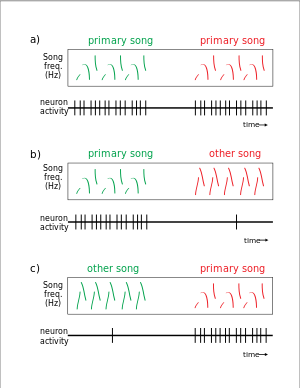User:Clm82/Sandbox
Mirror neurons and vocal learning[edit]
A mirror neuron is a neuron that discharges both when an individual performs an action, and when he perceives that same action being performed by another.[1] These neurons were first discovered in macaque monkeys, but recent research suggests that mirror neuron systems may be present in other animals including humans.[2]
Mirror neurons have the following characteristics:[3]
- They are located the premotor cortex
- They exhibit both sensory and motor properties
- They are action-specific – mirror neurons are only active when an individual is performing or observing a certain type of action (e.g.: grasping an object).
Because mirror neurons exhibit both sensory and motor activity, some researchers have suggested that mirror neurons may serve to map sensory experience onto motor structures.[4] This has implications for birdsong learning– many birds rely on auditory feedback to acquire and maintain their songs. Mirror neurons may be mediating this comparison of what the bird hears and what he produces.

In search of these auditory-motor neurons, Jonathan Prather and other researchers at Duke University recorded the activity of single neurons in the HVCs of swamp sparrows.[5] They discovered that the neurons that project from the HVC to Area X (HVCX neurons) are highly responsive when the bird is hearing a playback of his own song. These neurons also fire in similar patterns when the bird is singing that same song. Swamp sparrows employ 3-5 different song types, and the neural activity differs depending on which song is heard or sung. The HVCX neurons only fire in response to the presentation (or singing) of one of the songs, the primary song type. They are also temporally selective, firing at a precise phase in the song syllable.
Because the timing of the neural response is identical regardless of whether the bird was listening or singing, how can we be sure that the bird isn’t just hearing himself? Prather et al. found that during the short period of time before and after the bird sings, his HVCX neurons become insensitive to auditory input. In other words, the bird becomes "deaf" to his own song. This suggests that these neurons are producing a corollary discharge, which would allow for direct comparison of motor output and auditory input.[6] This may be the mechanism underlying learning via auditory feedback.
Overall, the HVCX auditory-motor neurons in swamp sparrows are very similar to the visual-motor mirror neurons discovered in primates. Like mirror neurons, the HVCX neurons:
- Are located in a premotor brain area
- Exhibit both sensory and motor properties
- Are action-specific – a response is only triggered by the ‘primary song type’
The function of the mirror neuron system is still unclear. Some scientists speculate that mirror neurons may play a role in understanding the actions of others, imitation, theory of mind and language acquisition, though there is currently insufficient neurophysiological evidence in support of these theories.[7] Specifically regarding birds, it is possible that the mirror neuron system serves as a general mechanism underlying vocal learning, but further research is needed. In addition to the implications for song learning, the mirror neuron system could also play a role in territorial behaviors such as song-type matching and countersinging.[8]
References[edit]
- ^ Rizzolatti, G., Craighero, L. (2004). "The mirror-neuron system." Annu. Rev. Neurosci. 27: 169-192.
- ^ Oberman, L. M., Pineda, J. A., Ramachandran, V. S. (2007). "The human mirror neuron system: A link between action observation and social skills." Social Cognitive and Affective Neuroscience 2: 62-66.
- ^ Rizzolatti, G., Craighero, L. (2004). "The mirror-neuron system." Annu. Rev. Neurosci. 27: 169-192.
- ^ Dinstein, I., Thomas, C., Behrmann, M., Heeger, D.J. (2008). "A mirror up to nature." Current Biology 18: R13-18.
- ^ Prather, J. F., Peters, S., Nowicki, S., Mooney, R. (2008). "Precise auditory-vocal mirroring in neurons for learned vocal communication." Nature 451: 305-310.
- ^ Tchernichovski, O., Wallman, J. (2008). "Behavioral neuroscience: Neurons of imitation." Nature 451: 249-250.
- ^ Dinstein, I., Thomas, C., Behrmann, M., Heeger, D.J. (2008). "A mirror up to nature." Current Biology 18: R13-18.
- ^ Miller, G. (2008). "Mirror neurons may help songbirds stay in tune." Science 319: 269.
